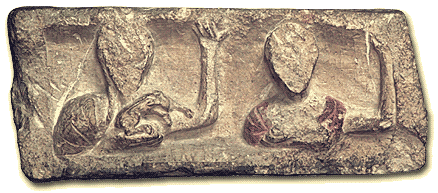- Home
- Architecture and settlement
- Places of worship
- A ritual room or space
Location of the ritual room or space
Three blocks sculpted in bas-relief were discovered in 1817 in a small house (mas) in the center of the plateau. According to M. de Loqui (in 1839), they originally came from the area around the medieval tower located on the summit of the site.
In 1851 they were carefully studied by E. Rouard and published with excellent lithographs. These architectural blocks could have belonged to the piers of a door, or to pillars that were joined to a wall.
Architectural block integrating two bas-relief orants (praying figures).
Face of one of the three sculpted blocks discovered in 1817.
The figuration seems to be both symbolic and narrative, though we are not able to fully understand its meaning. Three themes are distinguishable:
- armed cavalry soldiers caracoling (courage and victory);
- an unclothed person standing in front of a building or a door (a journey to the Afterworld?);
- humans heads, isolated or in pairs, sometimes integrated with vegetal motifs (skulls of the deceased, not necessarily simulacra of war trophies, but more likely allusions to cycles of the Afterworld or reincarnation?).
These stones perhaps constituted the piers of a monumental door opening into a room, or a delimited, ritual space. Meanwhile, the precise location of this place of worship remains hypothetical.
Lithographies published by E. Rouard and M. Reinaud in 1851.
Lithographies published by E. Rouard and M. Reinaud in 1851.




